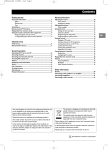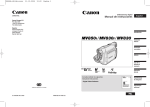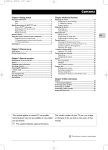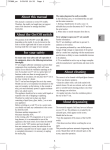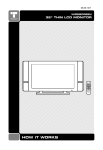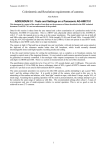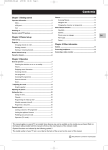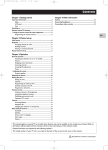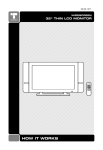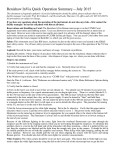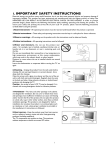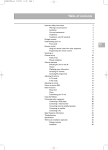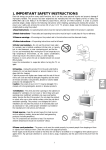Download Technicolor - Thomson ITC251 User's Manual
Transcript
itc251-en 2/02/06 11:42 Page 1 Contents Chapter1: Getting started Important information ....................................................................2 Safety ....................................................................................................2 Care ....................................................................................................2 Specific precautions for DLP™ TV sets..........................................3 What is DLP™ technology?............................................................3 Switching your TV set on and off ..................................................3 Replacing the lamp ............................................................................3 Moving the TV set..............................................................................3 Remote control ................................................................................4 Using the remote control for other equipment............................4 Programming the remote control..................................................4 Programming the volume control function ............................5 The Learning feature ....................................................................6 Switching on ......................................................................................7 EN Chapter 2: Channel set-up Initial set-up ......................................................................................8 Manual channel set-up......................................................................9 Chapter 3: General operation Switching the TV set on and off ....................................................10 Volume ............................................................................................10 Displaying status information ........................................................10 Accessing channels..........................................................................10 Accessing AV programmes ............................................................10 Zoom ................................................................................................11 List of programmes ........................................................................11 Freezing a picture ..........................................................................11 This manual applies to several TV set models. Some features may not be available on the model you purchased. This symbol indicates optional functions. The model number of your TV set is on a label at the back of the set and on the cover of this manual. Chapter 4:Advanced functions Adjusting the sound ........................................................................12 Configuring the sound settings ....................................................12 Headphone settings ..................................................................12 Graphic equaliser ............................................................................13 Adjusting the picture......................................................................13 Other settings ..................................................................................14 Lamp & Position ..............................................................................14 Setting the time ..............................................................................15 Setting the time................................................................................15 Programming the sleep timer ......................................................15 Programming the wake-up timer ................................................15 Parental control ..............................................................................16 Accessing the Parental control menu ........................................16 Locking the buttons on the front of the TV set ......................16 Operation (TV mode) ....................................................................16 Picture in Picture (PIP)..............................................................17 Operation (TV mode) ....................................................................17 Configuring AV sockets ..................................................................18 Teletext ............................................................................................19 Accessing Teletext............................................................................19 Navigator ..........................................................................................19 Other Teletext functions................................................................19 In the interest of improving the quality of our products, we reserve the right to modify their features.The information in this manual is, therefore, subject to change and does not represent any kind of contract. This symbol means that your inoperative electronic appliance must be collected separately and not mixed with the household waste.The European Union has a implemented a specific collection and recycling system for which producers' are responsible. This appliance has been designed and manufactured with high quality materials and components that can be recycled and reused. Electrical and electronic appliances are liable to contain parts that are necessary in order for the system to work properly but which can become a health and environmental hazard if they are not handled or disposed of in the proper way. Consequently, please do not throw out your inoperative appliance with the household waste. If you are the owner of the appliance, you must deposit it at the appropriate local collection point or leave it with the vendor when buying a new appliance. Chapter 5: Other information - If you are a professional user, please follow your supplier's instructions. Sockets ............................................................................................21 Connecting active speakers ..........................................................21 Connecting an amplifier ................................................................21 Connecting headphones ............................................................21 Connecting a video recorder ........................................................21 - If the appliance is rented to you or left in your care, please contact your service provider. Help us protect the environment in which we live ! This publication is printed on recycled paper. 1 itc251-en 2/02/06 11:42 Page 2 Chapter 1 Getting started Important information Safety Care Ensure that your domestic mains supply voltage matches the voltage indicated on the identification sticker located at the back of your set. EN Use a glass-cleaning product to clean the screen and a soft cloth and mild detergent to clean the rest of the set. Dust the vents at the back and sides regularly. Using solvents, abrasive or alcohol-based products could damage the TV set. The TV set's components are sensitive to heat.The maximum ambient temperature should not exceed 35° Celsius. Do not cover the vents at the back or sides of the TV set. Leave sufficient space around it to allow adequate ventilation. Install the appliance away from any source of heat (fireplace, ...) or appliances creating strong magnetic or electric fields. If an object or liquid enters inside the appliance, unplug it immediately and have it checked by an authorised engineer. THOMSON disclaims any liability if the TV set is not used in accordance with this manual. Moisture in rooms where the set is installed should not exceed 85% humidity. If you have to use the TV set outdoors, do not expose it to rain or splashing water. Do not place any object containing a liquid (vase, glass, bottle, etc.) on or near the set. Moving the set from a cold place to a warm one can cause condensation on the screen (and on some components inside the TV set). Let the condensation evaporate before switching the TV set on again. Before setting up your television set, make sure that the surface you want to put the set on can support its weight (see the list of specifications provided with the booklet). Don’t place the set on an unstable surface (e.g. moving shelf, very edge of a unit) and make sure that the front of the television set does not overhang the surface it is sitting on. If you intend to be away for a long period, switch the TV set off at the on/off switch A . Even when off, some components remain in contact with the mains electricity supply.To completely isolate the set you must remove the plug from the mains supply socket. Please respect the environment and the relevant regulations. Before you dispose of batteries (or accumulators), ask your dealer whether they require special recycling and if he is able to take them back. During thunderstorms, we recommend that you disconnect the TV set from the mains and aerial so that it is not affected by electrical or electromagnetic surges that could damage it. For this reason, keep the mains and aerial sockets accessible so they can be disconnected, if necessary. HELPLINE You can contact THOMSON by dialling: 0871 712 1312 (for United Kingdom, £0.10/mn inc VAT) Unplug the TV set immediately if you notice it giving off a burning smell or smoke.You must never, under any circumstances, open the TV set yourself, as you run the risk of an electric shock in doing so. www.thomson-europe.com Your TV set includes a high-performance electronic protection system to prevent damage by external influences, such as ESD (Electrostatic Discharge) or pollution on the mains power supply (Mains Transients). In the event of such external pollution, your TV set may shut down automatically, and you may need to switch it back on again using the remote control or the on/off switch A . Work carried out by unqualified persons or modifications to the high voltage may cause hazard. A set modified in this way no longer meets the original specifications and should not be switched on again. 2 itc251-en 2/02/06 11:42 Page 3 Getting started Specific precautions for DLP™ TV sets What is DLP™ technology? Replacing the lamp You have just bought a TV set equipped with DLP™ (Digital Light Processing) technology.This new technology uses a special lamp, a colour wheel and an optical semi-conductor comprising a huge number of microscopic mirrors to provide you with exceptional picture quality in a thin, lightweight design. The lamp supplied with the TV set has a lamp life of a few thousand hours in normal operating conditions. If you notice the following changes: - The time the TV set takes to come on gets noticeably longer. - The picture’s brightness decreases. - When you switch the set on, there is sound and you can change channels, but no picture is displayed and the indicator on the front starts flashing red.This occurs several times. To ensure that you can enjoy your TV set’s unparalleled operation for as long as possible, you should observe the following precautions. This means that the lamp’s power is running down. You then need to buy a new one. Switching your TV set on and off When you switch the TV set on, if no picture is displayed after 2 minutes, the lamp needs to be replaced. As with all projection devices, your TV set contains a special lamp which must heat up and cool down in the proper manner to ensure its optimum operation for as long as possible.To prolong the life of the lamp, you must observe the required heating up and cooling down times. Choose the exact same type and follow the instructions provided in the “Lamp replacement instructions” leaflet (the right lamp type is indicated in the help text for the Lamp brightness option in the Lamp & Position menu, see page 14). To switch the TV set on, press the on/off button on the side of the set.The picture takes up to 40 seconds to display. If no picture is displayed after 2 minutes, it is possible that the lamp needs to be replaced (see further below). Important: To put the TV set in standby mode, press the button on the remote control.When the set is in standby mode,the indicator on the front is red. To switch off the TV set, press the on/off button on the side of the set. - NEVER touch the lamp with your fingers because any grease deposits left on it can reduce the lamp’s life. Always use some kind of cloth to handle the lamp (gloves, duster, etc.). - Even after the fan has stopped, the lamp’s temperature still remains very hot for about 30 minutes and can cause burns. The fan continues to run for about another two minutes to cool the lamp down. Moving the TV set Important: NEVER unplug the set when the fan is running. To avoid any damage to the lamp, you should not move the TV set while the lamp is still hot.Wait 30 minutes after the the fan stops before moving it. Digital Light Processing and DLP are trademarks of Texas Instruments. Manufactured under license from Dolby Laboratories. “Dolby”, “Pro Logic”, and the double-D symbol are trademarks of Dolby Laboratories. TruSurroundXT, SRS and symbol are trademarks of SRS Labs, Inc. TruSurroundXT technology is incorporated under license from SRS Labs, Inc. 3 EN itc251-en 2/02/06 11:42 Page 4 Getting started Remote control Most of your television’s functions are available via the menus that appear on the screen.The remote control supplied with your set can be used to navigate through the menus and to configure all the general settings.The remote control and its functions may vary depending on the television model.The rest of this page contains the description of the most comprehensive remote control. Optional remote control features are indicated by the symbol . EN (green button) list of programmes (yellow button) status information (blue button) programme guide (purple button) Teletext The coloured buttons can also be used for operating Teletext. To select menu options. To set functions, change values, enable and disable functions (checkbox) in menus. To select the picture format or zoom. OK To confirm a selection, enable and disable functions (checkbox) in menus. MENU To access the OVERVIEW menu. EXIT To exit the menu structure. In PIP mode: to disable the PIP function. LIST INFO GUIDE TEXT Standby / quit standby. TV To access TV mode. Press this button to control the television. VCR To access VCR mode. DVD To access DVD mode. SAT To access SAT mode. AUX To access AUX mode. AMP To access AMP mode. light To provide information: - it lights up when you press a button, - it indicates the status when the remote control is being programmed (see page 5), - if the batteries are run down, it flashes when you press a button. PIP To enable the PIP function. SWAP To swap the main picture with the PIP picture. PIP+/PIP- To change programmes within the PIP function. ZOOM To change the size of the PIP picture. FREEZE To freeze the main picture. SLEEP (Disabled). LIGHT Remote control light. PRESETS (red button) sound and picture settings menu +/RETURN PR+/PR0-9 AV DEMO To control the volume. To switch the sound off and back on again. To return to the previous channel/AV programme. To change channels. To select a channel by its number. In the case of channel numbers with two digits, press 0 to display “-”, then enter the channel number. To select an appliance connected to an AV socket. To access demo mode. Using the remote control for other equipment The remote control supplied with your television may vary depending on the model you have chosen. Some remote controls can be used to control other appliances using the programmable buttons VCR, DVD, SAT, AMP and AUX. For each button you can control the following appliances: VCR: video recorder DVD: DVD player SAT: satellite receiver, cable network AMP: hi-fi system, Home Cinema amplifier AUX: decoder for terrestrial digital TV set and any other appliance. For instance, if you have two video recorders, you can program the VCR button to control one video recorder, and program the AUX button to control the other one. Note: The TV button is not programmable. Programming the remote control Automatic code search This method can be used to automatically find the most appropriate code for your appliance. 1. 2. Switch on the appliance you wish to use the remote control with. 3. Point the remote control at the appliance and press PLAY.Wait until the light stops flashing. If the appliance has not gone into standby mode, press the PLAY button again to continue the search for the next set of codes. Repeat this operation until the appliance goes into standby mode.There are around 20 sets of codes. 4. When the appliance goes into standby mode, switch it on again without using the remote control. Press the REV button as many times as is required to return the appliance to standby mode. 5. Press the STOP button and hold it down until the light or the appliance buttons of the remote control go off. Press the relevant button for this appliance on the remote control, and while holding this button down, press the until the light or the appliance buttons of the remote control come on. Release both buttons. Note:You can cancel the programming operation at any time by pressing the 4 EXIT button. standby button itc251-en 2/02/06 11:42 Page 5 Getting started Manual programming This method involves carrying out a manual search for the codes to be used for controlling your other appliances. 1. 2. Switch on the appliance you wish to use the remote control with. 3. Point the remote control at the appliance and press the relevant button (VCR, DVD, etc). Press the does not go into standby mode, try another code. Press the relevant button for this appliance on the remote control, and while holding this button down, enter one of the codes relevant to your make of appliance (there is a list of codes at the end of this manual). If the light or the appliance buttons of the remote control flash you have entered the wrong code or it is not possible to program the remote control. Depending on the year of manufacture and the type of appliance, some functions may not be available. Certain codes may cover more functions than others.Test the functions you can control and, if appropriate, try other codes. Note here the code(s) which work best. standby button. If the appliance VCR AUX DVD AMP SAT When you change the remote control’s batteries, remember to reprogram it. MENU OK EXIT 0-9 PR+/PRAV REV PLAY FWD STOP PAUSE REC Video recorder Press the VCR button On/Standby To display the main menu Vertical scrolling in menus Horizontal scrolling in menus To confirm an action To close a menu To directly access channels or enter numeric values To change channels To select av input Rewind Play Fast forward Stop Pause picture Record DVD player Press the DVD button On/Standby To display the main menu Vertical scrolling in menus Horizontal scrolling in menus To confirm an action To close a menu To enter numeric values or select options in menus To change chapters To select av input Rewind Play Fast forward Stop Pause picture Satellite receiver Press the SAT button On/Standby To display the main menu Vertical scrolling in menus Horizontal scrolling in menus To confirm an action To close a menu To directly access channels or enter numeric values To change channels Hi-fi system Press the AMP button On/Standby To select a station using its number To change stations To switch the sound off and back on again To set the volume level +/- Programming the volume control function If you have programmed the TV remote control to use with other appliances and these are connected to an amplifier you can also programme the remote control to adjust the volume when you are using one of these appliances.The example below describes the procedure for programming a DVD player. 1. 2. 3. 4. Programme the AMP button on the remote control to use with the amplifier (refer to page 4). Move the remote control away from the appliances. Press the - button and while holding it down, press the relevant mode button (DVD, in this example), then the AMP button. Release the - button. Switch on the amplifier, then the DVD player. Set the remote control to DVD, play a disc and adjust the volume using the +/- buttons. Repeat this operation for the other appliances. To cancel the programmed function for any of the appliances, press the the numeric buttons. 5 - button, while holding it down and enter the code 000 using EN itc251-en 2/02/06 11:42 Page 6 Getting started The Learning feature The Learning feature completes the programming procedure described on page 4, as it enables you to record the functionality of a specific button from the original remote control to one of the TV’s remote control buttons. Notes: - Before using the Learning feature, make sure this TV’s remote control is programmed to control other appliances you have connected to the TV. Programming the remote control erases all learned commands for that appliance mode. - You cannot record a learned function to the following buttons on the TV’s remote control: TV, VCR, DVD, AUX, SAT, AMP, EXIT, and LIGHT. - The remote control functions are recorded (learned) by sending infrared (IR) signals: this operation should be carried out in a dimly lit room to avoid interference. Make sure the TV’s remote and the original remote are no more than 5 cm apart, with the Infrared (IR) transmitter of the original remote facing the IR receiver on the top of the TV’s remote. - The learned buttons are mode specific—if you add a button function from your DVD player’s remote control, you must press the DVD button first before the learned function will work (in TV mode, the button where you’ve stored the learned function will continue to work as it always has). - Certain remote controls do not support the use of the Learning function. EN Adding a Learned Function 1. On the TV remote, press and hold the appliance button that applies to the function you will be adding (DVD, VCR, SAT, AMP, or AUX).The appliance button lights up. Press and hold the REC button. 2. The appliance button lights turn on, then off. Release both buttons.The relevant appliance button light remains on. 3. On the TV’s remote control, press the button where you want to store the new function (the appliance button turns off and then back on). Note: If you press an invalid button on the TV remote, the appliance buttons flash several times to alert you.You’ll have to repeat step 3. 4. Press and hold the button of the appliance’s remote control that has the functionality you are recording to the TV’s remote control. Keep pressing the button until the TV remote’s appliance button light turns off and back on.The function has been saved to the TV remote. Note: if it is not possible to programme this function the appliance buttons flash several times. You’ll have to repeat step 3. 5. Repeat this procedure to add more functions. Or, press EXIT to exit learning mode. Note: If you want to assign a new function to a button already programmed, you must record over it. Clearing a Learned Function 1. Press and hold the relevant appliance button (the appliance button lights up).Then press and hold the EXIT button. 2. The appliance buttons turn on. Release the appliance and EXIT buttons (the appliance button being unprogrammed remains on). Remote is now in Clear learned function mode. 3. Press the button where learning is to be cleared.The appliance button flashes off then back on—the learned function was cleared successfully. 4. Repeat steps 1 through 3 to clear more learned functions. Note: If an invalid button is pressed, the appliance mode button(s) flashes 4 times to alert you. Repeat step 3. 5. Press the EXIT button and your TV remote returns to its original operating mode. Deleting ALL Learned Functions 1. Press and hold the EXIT button.The current appliance button lights up.Then press and hold the button. 2. The appliance button lights turn on, then off. Release both buttons.The current appliance button light remains on. 3. Press any appliance button to delete all learned functions in all modes. Important: If the batteries in your remote control are run down, you can use the buttons on the front of your set, as they have the same functions as those on the remote control. 6 itc251-en 2/02/06 11:42 Page 7 Getting started Switching on Follow the instructions on this page on how to switch on your TV set and the remote control before going on to the following pages that describe the channel set-up procedure. 1. Insert two LR06 or AA batteries in the remote control. Precautions on using batteries: - Only use the battery types specified. - Make sure you use the correct polarity. - Do not mix new and used batteries. - Do not use rechargeable batteries. - Do not expose batteries to excessive heat, throw them in a fire, recharge them or try to open them, as this could cause them to leak or explode. - Remove the batteries from the remote control if you are not using it for a long period of time (several weeks). 220 - 240 V ~ 50 Hz 2. Connect the power cable FIRST to the television, THEN to a mains socket. Your TV set should only be connected to a 220 - 240 V ~ 50/60 Hz AC supply. It must not be connected to a DC supply. If the plug is detached from the cable, do not, under any circumstances, connect it to a mains socket, as there is a risk of electric shock. Mains socket in continental Europe Equipment for the UK and Ireland is supplied with a mains cable fitted with a moulded plug. 5A This plug contains safety components and must not be replaced by one sold by general retailers. It is fitted with a fuse that protects your television. If your set has stopped working, the fuse may have blown. If it has, replace it with an identical ASTA or BSI certified (BS 1362) 5-amp fuse. 3. Connect the outside aerial or cable network to the g socket at the back of the TV set. The aerial socket (75 Ohms - VHF / UHF / cable) can be used for connecting an external aerial or other equipment fitted with a modulator (video recorder, satellite receiver, etc.). We recommend that you do not connect other equipment (video recorder, satellite receiver, etc.) to your TV set to begin with, so as not to complicate the set-up procedure with the additional steps involved. Connect them when you have finished setting up the channels by referring to page 24 of this manual. LAMP ACCESS DOOR PORTE D'ACCES A L'AMPOULE PUERTA DE ACCESO A LA LAMPARA 4. Switch the TV on by pressing the on/off button A on the side.The TV set takes up to 40 seconds to come on. Important: read carefully the sections “Specific precautions for DLP™ TV sets” on page 3 and “Switching the TV set on and off ” on page 10, which give a detailed description of the procedure for switching the TV set on and off. Note: The first time you switch on the television, the language selection menu appears. You will find a description of how to use the remote control on page 4.Then go to page 8 for information on the initial set-up, or to page 9 for information on manual set-up (if the channels have already been set up on your TV). Note: Before connecting other devices to the AV sockets, carry out the initial channel set-up (described on the next page) in order to avoid any problems with equipment selection. 7 EN itc251-en 2/02/06 11:42 Page 8 Chapter 2 Channel set-up Initial set-up Initial set-up involves searching for and storing all the channels you can receive. Make sure that the television is switched on and follow the six steps in turn specified on this page. The first time you switch the television on, the language selection menu appears. 1 English Français Deutsch Italiano Español Nederlands Norsk Svenska Português Dansk âe‰tina Eλληνικα Magyar Polski Русский EN 1. Select your language using the buttons and confirm by pressing OK. A welcome message appears in the language you have just chosen. Press OK. 2. A list of countries appears. Select the relevant country using the OK to confirm. Note: This is the country you are in, or the country whose channels you want to receive if you live near its borders. 3. A message appears asking you to check that your aerial is connected, and if relevant, to connect your decoder. Once this operation has been carried out, press OK. 4. The Installation menu appears.The Auto installation option is selected. Start the automatic set-up by pressing OK. Notes: - The automatic set-up process can take up to 10 minutes. The menu that appears tells you how the process is progressing. To prevent the channel set-up process from being interrupted, wait for the message indicating that the set-up is complete before closing the menu. - The automatic set-up process deletes all the channels previously stored. 2 5. Country selection Return UK Italy Switzerland Denmark Belgium Czech Republic Poland New Zealand Other buttons. Press France Spain Sweden Norway Finland Greece Russia Singapore Germany Netherlands Portugal Austria Luxembourg Hungary Australia Hong Kong keys. Select your country with the / To validate, press OK. Channels are arranged in a pre-set order. - To modify this order, name and rename channels or delete channels stored twice, press OK and go to step 6. - If you do not want to reorganise the channels, press EXIT to close the menu. 6. The Organiser menu allows you to change the order of the channels as arranged during the automatic set-up process, to name or rename channels, as well as delete channels stored twice or with poor reception quality. Simply follow the instructions at the bottom of the screen. Use a TV programme magazine to identify the channels. Organising channels: Select the Select programme option. Using the PR+/PR-, or numeric buttons, display the channel number and look for the channel to be moved. Select the Swap with pr. option and enter the number you want to assign this channel to. Press OK. Changing a channel name: Select the Select programme option. Using the PR+/PR-, or numeric buttons, display the number of the channel whose name you want to change. Select the Change name option and choose a name from the list using the buttons. Press OK. Auto installation 4 Deleting a channel: Select the Select programme option. Using the PR+/PR-, or numeric buttons, display the number of the channel to be deleted. Select the Delete programme option and press OK. 23 programmes found When you have finished press EXIT to close the menu. Searching... Auto installing your TV set. Please wait. To cancel press EXIT. (any programmes already found will remain stored) To access the Organiser menu another time, press the MENU button to display the OVERVIEW menu, select Installation and press OK.Then select Organiser from the Install. menu. 6 Organiser Return Select programme Swap with pr. Change name Delete programme 20 ARD 21 ZDF 22 BBC1 23 BBC2 24 ITV 25 25 ESPORT -ESPORT 26 SAT1 27 VOX 25 28 TF1 29 TF2 Select the name using the ¦/ keys, then press OK. 8 itc251-en 2/02/06 11:42 Page 9 Channel set-up Manual install Manual channel set-up Return Standard Reception Channel search Fine tuning Store on programme Name I... Aerial... CH 01 01 BBC1 keys, or enter the channel number. Use the ¦/ Follow the procedure given on this page if you find that some channels have not been stored during the initial set-up.This can happen if you are setting up cable network channels. Setting up channels manually requires every setting for a particular channel to be entered, one at a time. Display the OVERVIEW menu by pressing the MENU button. Select the Installation option and press OK to confirm. Select the Installation option from the Install menu and press OK to confirm. 1. Select your country using the buttons. Press OK to confirm.The Connections screen appears. Press OK to continue.The Installation menu appears. Select the Manual installation option and press OK. Define all the settings in turn for each channel to be stored. Follow the instructions appearing at the bottom of the screen. 2. Select the Standard option. Use the country. or button to select the standard for your Note: The following standards are available to choose from: I for the UK and Ireland, France for France and Luxembourg, DKK’ for Eastern Europe, the Middle East and Asia, EURO BG for Western Europe, Australia and New Zealand. 3. Select the Reception option. Select the reception method for the channels (aerial or cable network) using the or button. 4. Select the Channel search option. Enter the number of the reception channel or use the buttons to find the channels.When a channel has been found the picture is displayed. 5. If the picture is not clear you can adjust the setting.You do this by selecting the Fine tuning option and adjusting it with the buttons. 6. Select the Name option. Place the cursor appears at the first dash. Scroll through the alphabet using the 1 and 2 buttons. Go to another character using the buttons. 7. Then select the Store on programme option and enter the number to be assigned to this channel using the numeric buttons (for instance, for BBC1 type 01). Press OK. Important: Whenever you change a value in the Manual install menu, the Store on programme option starts flashing. To confirm your change you need to select the Store on programme option and press OK. If you do not confirm the change it will be cancelled when you change channels or put the TV set in standby. Repeat this procedure to find other channels. Notes: - For cable networks, to search for missing channels, select Other instead of a country, then select Auto update in the Installation menu. - If you wish to go through the whole initial set-up process, put the TV in standby mode, then hold + buttons on the television until the menu displays. Proceed as for the down the PR+ and initial set-up. - Subsequent set-ups: - The Auto update function allows you to set up channels just launched or any channels that are missing or wrongly set up. - The Auto installation function is used for setting up channels after the initial set-up (e.g. after moving house). This process deletes all channels previously stored. To set up a new channel, it is better to use Auto update or Manual installation. 9 EN itc251-en 2/02/06 11:42 Page 10 Chapter 3 General operation Switching the TV set on and off To switch the TV set on, press the A button located on the side of the set.The TV set takes up to 40 seconds to come on. If the indicator on the front is red, the set is in standby mode.You can then: - press the or any numeric button on the remote control, - press the TV, OK or PR+/PR- buttons to switch the television on at the last channel or AV programme you were watching, - press the AV button to switch the television on at the last AV programme you were watching. EN When the set is on, the indicator on the front is green or blue. To put the TV set in standby mode, press the button on the remote control.When the set is in standby mode,the indicator on the front is red.The TV set remains powered up, but with low energy consumption. To switch off the TV set, press the on/off button on the side of the set. Note: The fan continues to run for about another two minutes after the TV set has been switched to standby mode. Volume Volume control: use the +/- buttons on the front of the TV set or press the relevant buttons on the remote control to increase or decrease the volume. Sound mute: press the button to temporarily mute the sound. Press this button again or the + button to restore it. Displaying status information In TV mode, press the yellow button (INFO) on the remote control to display the number and name of the channel you are watching, the time, the type of sound, and the zoom or format. When you switch on the television or change channels, the number and name of the channel are displayed. Accessing channels Using the numeric buttons: - for channels 1 to 9, press the corresponding button; - for channels 10 to 99, press the 0 button to display “--”, then enter the two digits. Using the PR+/PR- buttons: scroll through the channels. AV programmes are not included in the cycle unless you use the buttons on the front of the TV set. Using the list of programmes: refer to page 11. To access the channel or AV programme previously being watched, press the RETURN button Accessing AV programmes Press the AV button to display the last selected audio-visual programme and scan through the other audio-visual programmes. Av selection loop: AV1, AV2, AV3, COMP, HDMI,VGA. 10 itc251-en 2/02/06 11:42 Page 11 General operation Zoom In TV mode, you have the option of changing the display format and using the zoom function via the buttons.The available formats and zoom functions are: 4/3 format - picture in centred 4:3 format Zoom 14/9 - picture in centred letterbox 14:9 format Zoom 16/9 - picture in centred letterbox 16:9 format Zoom 16/9 /- picture in 16:9 format with subtitles Cinerama - picture in widescreen 4:3 format 16/9 format - picture in widescreen 16:9 format In Zoom 14/9, Zoom 16/9, and Zoom 16/9 / modes, you can temporarily shift the picture up and down using the buttons. For HDTV, Progressive Scan, HDMI, and PC (VGA) sources, some of these modes are not available. List of programmes List 01 02 03 04 05 06 07 08 09 ARD ZDF SAT1 ESPORT RTL RTL2 VOX SW3 WDR Select prog.: OK or last digit of number Page +: Page -: ¦ Press the LIST (green) button on the remote control to display the LIST of programmes. It has 11 pages and shows the name and the number of each programme.The last page lists units connected to the AV sockets. The list appears on the page featuring the channel or AV programme which you are currently watching.The channel or AV programme you are watching is indicated by a symbol. To watch one of the programmes on the displayed page, use the PR+/PR- or buttons and press OK.You can also enter the last digit of the programme number (for example, 5 for 25).The selected programme is shown. You can scroll through the pages using the buttons. Press EXIT to close the menu. Freezing a picture Press the FREEZE button to freeze the picture. Press any button on the remote control or TV set to cancel this function. In PIP mode, press the FREEZE button to freeze the main picture. 11 EN itc251-en 2/02/06 11:42 Page 12 Chapter 4 Advanced functions Adjusting the sound Display the OVERVIEW menu by pressing the MENU button. Select the Sound option and press OK to confirm.The SOUND menu appears with the following options: Sound Return Sound settings Sound type Sound mode SRS mode SRS Dialogue Clarity Automatic sound level Headphone settings Graphic equaliser ... Stereo... Dolby Virtual... SRS TruSurroundXT... ... ... Sound settings: see further below. Sound type: select a sound type from the list using the buttons. The default sound type is Automatic for mono sources, Stereo for stereo sources and Stereo for AV sources. Note: The options offered depend on the programme you’re watching. Refer to the table1 opposite. EN Sound mode:The options available depend on the sound type selected (refer to table 2 1 Options Automatic - Mono Mono - Stereo Sound 1 - Sound 2 Sound 1 - Sound 2 - Sound 3 Stereo - Sound 1 - Sound 2 Broadcast Mono Stereo Dual NICAM - 3 Analog AV opposite). Default mode for mono sources is Normal and Virtual Dolby PLII for stereo sources. SRS mode: the options available depend on the mode selected (refer to table 3 opposite) Using the buttons, select an option from the list: - SRS TruSurroundXT: reproduces virtually via two channels only the sound of a multichannel source and enhances the dialogue and bass output. - SRS TruSurround: reproduces virtually via two channels only the sound of a multichannel source. 2 Options Normal - Wide Normal - Virtual Dolby PLII Normal - Wide Normal - Wide Sound type Mono Stereo Sound 1 Sound 2 3 - SRS TruBass: enhances the bass output. SRS Dialogue Clarity: this function boosts the central channel to make dialogue easier to understand.You can use the buttons to adjust it. Note: This option only appears if you have selected Normal or Virtual Dolby PLII under Sound mode and SRS TruSurroundXT under SRS Mode. Automatic sound level: check the box by pressing the OK button, if you want to keep Sound mode Normal* Wide Virtual Dolby PLII Options SRS TruSurroundXT SRS TruSurround SRS TruBass - Off SRS TruBass - Off SRS TruSurroundXT SRS TruSurround * Only the options SRS TruBass and Off are available for mono sources. the same sound level for all channels. Headphone settings: this option allows access to the headphone setting menu (see further below). Graphic equaliser: this option allows access to the graphic equaliser (see further below). Press EXIT to close the menu. Select Return and press OK to return to the OVERVIEW menu. Configuring the sound settings You can configure the sound environment according to the loudspeakers you connect to the TV set. Set Return Left/Right balance Left/Right speakers Subwoofer External... External... Select the Sound settings option from the Sound menu and press OK to confirm.The options are the following: Left/Right balance: balance the sound between the left and right speakers. Left/Right speakers: select External if you have connected external side speakers (see page 24), Internal if you have not. Otherwise, there would be no sound. Subwoofer: select None, if you do not want to use a subwoofer; Internal, if you are using the television’s subwoofer; External, if you have connected an external subwoofer. Note: The Internal option is only available if the television has a subwoofer. Press EXIT to close the menu.To return to the Sound menu, select Return and press OK to confirm. Headphone settings Select the Headphone settings option from the Sound menu and press OK to display the menu.Then select each option in turn, using the buttons to adjust the volume, bass and treble level and select the sound type. HP set Return Headphone Headphone Headphone Headphone volume bass treble sound Stereo... Press EXIT to close the menu.To return to the Sound menu, select Return and press OK to confirm. 12 itc251-en 2/02/06 11:42 Page 13 Advanced functions Graphic equaliser Return Film... Equaliser Sound preset Select Graphic equaliser from the Sound menu and press OK to display the menu. This menu is used to select a preset parameter and define your own settings using the graphic equaliser. It offers the following options: Sound preset: use the buttons to select the appropriate setting for the programme you are watching. The Personal setting stores your graphic equaliser settings. Your selection is applied to all channels and AV programmes. Frequency range Treble (12 kHz)... Frequency range: the graphic equaliser has seven frequency bands. Select each band in turn using the buttons and make the necessary adjustments using the buttons. Press OK to confirm. Note: When you are setting the graphic equaliser, Personal appears under the Sound preset option. Press EXIT to close the menu.To return to the Sound menu, select Return and press OK to confirm. Adjusting the picture Picture Return Other settings Picture preset Brightness Colour Contrast Sharpness Tone Tint Lamp & Position ... Personal... Neutral... ... The menus for adjusting the picture are used to obtain the best picture setting according to your preference, the type of programme you are watching and the ambient lighting.When you make an adjustment only the selected option remains displayed, allowing you to see the changes taking place on screen. The entire menu is displayed again when you select another option or the time for making an adjustment has elapsed. Display the OVERVIEW menu using the MENU button. Select Picture and press OK to confirm.The Picture menu appears with the following options: Other settings: this option provides access to the Other settings menu (see further below). Picture preset: use the buttons to select the appropriate setting for the programme you are watching. Personal contains the values you have defined for the settings Brightness, Colour, Contrast, Contrast expand, Sharpness., Auto noise reduction, Tone, and Tint. You can select a preset parameter for each AV programme. Brightness, Colour, Contrast, Sharpness: adjust these settings as required using the buttons. Note: These settings are automatically stored under Personal under the Picture preset option. Tone: adjusts the colour temperature. Select an option from the list using the buttons. Tint: is used to adjust the picture’s tint. Make the necessary adjustments using the buttons. Note: This function is only available for NTSC audio-visual sources. Lamp & Position: this option provides access to the Lamp & Position menu (see further below). Picture Return Brightness Colour Contrast Tone Some menu options are not available in PIP Split screen mode (see opposite). Warm... Press EXIT to close the menu.To return to the OVERVIEW menu, select Return and press OK to confirm. 13 EN itc251-en 2/02/06 11:42 Page 14 Advanced functions Other settings Other settings Select the Other settings option from the Picture menu and press OK to display the menu.The options are the following: Return Contrast expand Automatic format Auto noise reduction Auto skin tone Film mode PC Mode Medium... Low... Advanced... Video... Contrast expand: can be used to adjust the picture according to the ambient brightness. Select an option from the list using the buttons. Automatic format: automatically applies the appropriate format to the picture. Check this box by pressing OK to enable this function. Auto noise reduction: improves the quality of the picture in the case of poor reception. Select an option from the list using the buttons. EN Auto skin tone: improves skin tone rendering. Check the box to enable this function by pressing OK. Note: This function is only available for NTSC audio-visual sources. Film mode: detects that the programme being broadcast is a film and enhances picture quality. Select an option from the list using the buttons. PC Mode: If you connect a PC to your TV set, using either the VGA, HDMI or component sockets, you can select the PC option from the list using the buttons. In PC mode, the TV set reduces the PC image so that you can see the whole image. Notes: - The Video option is selected by default.. - This function is only available for the VGA, HDMI and COMP AV sources. Press EXIT to close the menu.To return to the Picture menu, select Return and press OK to confirm. Lamp & Position Lamp & Position Select the Lamp & Position option from the Picture menu and press OK to display the menu.The options are the following: Return Lamp brightness Horizontal position Vertical position Normal... To adjust the vertical position of the picture, press ¦ or . Lamp brightness: this function is used to adjust the lamp brightness. Select an option from the list using the buttons. Note: The Boosted option increases brightness but reduces lamp life. The help text also indicates the relevant lamp type for your set. Write down here the lamp type for future reference: Horizontal position: use the buttons to move the picture horizontally on the screen. Vertical position: use the buttons to move the picture vertically on the screen. Note:You can adjust the vertical and horizontal positions for each source. Press EXIT to close the menu.To return to the Picture menu, select Return and press OK to confirm. 14 itc251-en 2/02/06 11:42 Page 15 Advanced functions Setting the time The TIME menu can be used to set the time on the TV set and program the automatic sleep timer or wake-up timer functions. Return Time Sleep timer Clock reference programme Time Wake-up timer Wake-up time Switch on for Programme number Daily 00:15 02 12:34 07:00 01:00 10 CNN Display the OVERVIEW menu by pressing the MENU button. Select the Time option and press OK to confirm. Setting the time 1. Select the Clock reference programme option. 2. Select a channel with Teletext which can provide the time to be used as a reference using the buttons, or enter a channel number using the numeric buttons on the remote control.The time is displayed after a few seconds if it is available on the selected channel. If the time is not provided by Teletext the Wake-up timer function is not available and a message prompts you to change reference channel or enter the time manually. You do this by selecting the Time option and entering the time using the numeric buttons or the buttons. Note: If the power supply is disrupted (i.e. the set is switched off using the on/off button or unplugged, or there is an electrical fault), the time will disappear if it has been entered manually. You must reset it. We therefore recommend you find the time on a channel and check that it is correct. Once the time has been set you can use the Wake-up timer function. Programming the sleep timer 1. Select the Sleep timer option. 2. Set an automatic shut-off time (from 0 to 4 hours in 5-minute intervals) by using the buttons. Set the time to 00:00 to disable this function. When the sleep timer is on, a message appears one minute before the television set goes into standby mode. Press any button on the remote control to cancel standby mode. Programming the wake-up timer This function can be used to set the time for the set to come on, for instance, for the television to wake you up. 1. Select the Wake-up timer option and press OK to check the box, which enables this function and provides access to the relevant options. 2. Under the Wake-up time option enter the wake-up time using the numeric or buttons. 3. Under the Switch on for option, use the buttons to set the period of time (from 5 minutes to 4 hours in intervals of 5 minutes). 4. Under the Programme number option enter the number of the channel you want to wake you using the or numeric buttons.You can also select an AV programme using the AV button. In this case, make sure you programme the equipment connected to the AV socket to come on as well. 5. 6. 7. For a daily wake-up check the box for the Daily option by pressing OK. Press EXIT to close the menu. Put the TV set into standby mode using the button on the remote control. The TV set will automatically switch on at the programmed time and for the programmed duration if you do not interrupt it by using the remote control. 15 EN itc251-en 2/02/06 11:42 Page 16 Advanced functions Parental control The parental control functions allow you to limit your children’s access to the television. You can do this by locking the buttons on the front of your TV set, thereby barring access to certain channels and/or AV programmes.These functions are protected using a PIN code. Accessing the Parental control menu 1. Display the OVERVIEW menu by pressing the MENU button. Select the Parental control option and press OK to confirm. EN Parental control 2. Locking the buttons on the front of the TV set 1. Select the Lock front panel option from the Parental control menu and check Return Lock front panel Activate parental control If the parental control function is not on, follow the instructions on the screen to access the menu. If it is on, the Pwd menu appears. Enter your 4-digit code to access the menu. On the screen the numbers are replaced with asterisks.The Parental control menu appears. the box by pressing OK or the ... To lock or unlock the front panel, press ¦ or . buttons. 2. Select the Activate parental control option and press OK.The Lock menu appears. 3. Enter a 4-digit code, then enter it again to confirm it. A message appears saying that the parental control is on. Press EXIT to close the menu. Press any other button to return to the Parental control menu. Note: The Installation menu is also locked and the remote control is needed to be able to use the television. To cancel the lock, go to the Parental control menu by entering your code and uncheck the Lock front panel box by pressing OK. Press EXIT to close the menu. Operation (TV mode) The parental control function must be enabled without fail in order to be able to apply a lock.To do this you need to select the Activate parental control option from the Parental control menu to define a personal code. Whenever you enable the parental control function by defining a personal code you have to enter your code to access the Parental control and Installation menus, even if there is no lock on. In the Parental control menu the option is replaced by Deactivate parental control. To disable the parental control function, access the Parental control menu by entering your personal code, select the Deactivate parental control option and enter your code again.This option is then replaced by Activate parental control. The personal code is deleted every time you disable the parental control function.This means you have to redefine it every time you enable this function again. Whenever you enter your code all the locks are disabled until the set is put in standby again. If you have forgotten your PIN code you can cancel it: When you are prompted to enter your code to access the Parental control menu, press the PR+ and + buttons on the front of your set at the same time for eight seconds.This procedure is possible, even if you have locked the buttons on the front of the TV set. 16 itc251-en 2/02/06 11:42 Page 17 Advanced functions Picture in picture (PIP) Press the MENU button to display the OVERVIEW menu. Select Picture in Picture and press OK.The menu displays. Under the Display mode option, select one of the following PIP display modes: - Off: PIP is disabled. PIP - Single: a channel or av programme is displayed in a frame in a corner of the screen. Return Display mode Programme Zoom Position PIP... 01 Minimum... Upper right... - Split screen: the screen is divided vertically in two and the PIP is displayed on the right side. Sound comes from the main programme, on the left. When you enable the PIP function, the other options in the menu are displayed. - In Single mode, you can select the programme, the zoom and the position of the frame on the screen. Select an option from the list each time using the buttons. - In Split screen mode, you can select the programmes to be displayed in both pictures. Use the PR+/PR- buttons to change programmes on the left side of the screen and use the PIP+/PIP- buttons to change programmes on the right side of the screen. Use the SWAP button to swap pictures. PIP Press EXIT to close the menu. Select the option Return and press OK to return to the Return Display mode Programme OVERVIEW menu. Split screen... 01 Operation (TV mode) Use the PIP button on the remote control to enable the different display modes in turn. In both display modes: - Use the SWAP button to swap the channels around. - Press the FREEZE button to freeze the main picture. - To apply the PIP function to an AV programme in RGB, you need to select RGB as the relevant AV source in the AV Settings menu (see page 19). In Single mode: - Use the PIP ZOOM button to change the size of the PIP picture. In Split screen mode: - Use the PIP+/PIP- buttons to change programmes on the right side of the screen. 17 EN itc251-en 2/02/06 11:42 Page 18 Advanced functions Configuring AV sockets You can configure your TV set according to the equipment you connect to it. AV settings Return EN AV1 name AV1 video input AV2 name AV2 video input AV3 name AV3 video input COMP name HDMI name Select the name of the device connected to AV1. DECOD. RGB... VCR1 S-Video... CAMCOR Video... DVD... DVI... Display the OVERVIEW menu using the MENU button. Select the Installation option and press OK to confirm.The Install menu appears. Select the AV settings option and press OK to confirm. Follow the messages on screen and the instructions below explaining how to configure the AV sockets. AV1 name: Use the buttons to select from the list the name of the equipment connected to this socket. If the factory preset names do not suit you, select AV1__ and enter another one, following the screen messages. AV1 video input: use the buttons to select from the list the type of video signal transmitted by the equipment connected to the AV1 socket. Note: Select RGB if no picture is displayed when you connect a games console. Repeat the above procedure to configure the AV2 and AV3 sockets. COMP name: Use the buttons to select from the list the name of the equipment connected to the COMP sockets. If the factory preset names do not suit you, select COMP _ _ and enter another one, following the screen messages. buttons to select from the list the name of the equipment VGA name: Use the connected to this socket. If the factory preset names do not suit you, select VGA _ _ _ and enter another one, following the screen messages. Note: This option is only displayed if your TV set has a VGA socket. HDMI name: Use the buttons to select from the list the name of the equipment connected to this socket. If the factory preset names do not suit you, select HDMI _ _ and enter another one, following the screen messages. Press EXIT to close the menu. Select the option Return and press OK to return to the Install menu. 18 itc251-en 2/02/06 11:42 Page 19 Advanced functions Teletext Other Teletext functions The Teletext service is available in many countries under a variety of names (TOP Text, Fastext, FLOF text,Videotext). It is provided as a free service by television broadcasters.This service provides a real wealth of information, available at any time, on weather, sports results, news, games, etc.The information is presented in pages or organised in topics specified in colour on the screen and you can access this information by simply pressing the buttons of the relevant colour on the remote control. Subtitles Some channels provide subtitles for some of their programmes. The number of the relevant pages is specified on the Teletext index page. To display subtitles, enable the Teletext function, find the number of the page displaying the subtitles and enter it. Once the relevant page is found, the subtitles appear in the TV picture.The navigator disappears after a couple of seconds.To display it again, press the purple (TEXT) button. Accessing Teletext Press the TEXT button on the remote control.Teletext will display the last page selected, or if you have changed channel, the index page (usually 100). If the particular programme does not provide a Teletext service, a message will appear to this effect. Direct access The red, green, yellow, and blue buttons on the remote control allow you to access directly those pages whose numbers are displayed in the corresponding colours at the bottom of the screen. To display a page, enter its 3-digit number or use the PR+/PRbuttons.The page appears after a few moments.The entered number appears: -red if the page number has not yet been found, -white if the page has been found, -green when a sub-page has also been found for this page, -yellow when the page exists but has not been found yet. Fastext Fastext displays a bar at the bottom of the page divided into four coloured sections (red, green, yellow and blue), which provide links to the topics you can access by pressing the relevant colour button. Other topics accessible in the same way can also be displayed. If the current page includes subpages, the page number is displayed in green. In this mode, pressing the buttons will allow you to step through all the available subpages. You can select a specific subpage number by pressing 0 to enter subpage direct access mode.The display will look like this: 120 ----. You can then enter the four digits of the sub-page number using the numeric buttons (e.g. 0003). TOPtext TOPtext displays a bar at the bottom of the page divided into four coloured sections (red, green, yellow, and blue).The red section gives access to the previous available page, and the green section to the next available page.The blue section displays a topic you can access directly by pressing the blue button.The next topic will then appear in the blue section.The yellow section displays an article you can access directly by pressing the yellow button.The next article will then appear in the yellow section. Navigator The navigator, located on the left of the screen, provides access to the following functions: Stop Some information is spread over several subpages which will be displayed one after the other.To stop subpage scrolling, select STOP and press OK. Press OK to allow the information to move again. Hidden answers To reveal a hidden answer (for example, in games), select press OK. Press OK once more to hide the answer again. and Zoom Select and press OK: once to zoom in on the top part of the screen, twice to zoom in on the bottom part of the screen and three times to return to normal display. Mixed display Select and press the OK button to display Teletext in the right half of the screen. Press the EXIT button to quit Teletext. 19 EN itc251-en 2/02/06 11:42 Page 20 Chapter 5 Other information Sockets AV1 and AV2 SCART sockets (input-output) at the back AV3 These sockets can be used to connect a range of equipment, including video recorders, camcorders (VHS, S-VHS, 8 mm or Hi 8), decoders, satellite receivers, DVD players, games consoles or devices producing an RGB signal. AV1 AV2 AV3 SCART socket (input) at the back EN This socket can be used to connect equipment, such as video recorders or camcorders (VHS, S-VHS, 8 mm or Hi 8). RCA audio and video component (synchroscan) sockets (input) at the back Y Pb L Pr R These can be used to connect a DVD player.The component sockets automatically detect the type of component signal received: interlaced component (Y/Pr/Pb) or progressive component (Y/Cr/Cb).The supported formats are 480i, 480p, 576i, 576p, 720p, and 1080p. HDMI socket (input) at the back This can be used to connect a PC with a compatible graphics card, certain DVD players or a compatible high-definition digital satellite decoder.This socket allows a very high transmission quality for the audio and video signals.To connect a device with a DVI socket, you can use the HDMI socket and the RCA audio sockets. In this instance, the HDMI socket is used for receiving the video signal and the RCA sockets for receiving the audio signal. An HDMI-DVI cable is required. This socket supports many picture formats including HDTV (720p, 1080i, and 1080p) and PC sources (up to SXGA resolution). HDMI Notes: - Do not connect a device supplying analogue RGB signals to this socket. - The HDMI socket is compatible with HDCP format. RCA audio + VGA sockets (input) at the back These can be used to connect a computer.This socket supports many PC video formats, up to SXGA resolution. SUB-WFR Audio RCA sockets (output) at the back These can be used to connect a stereo amplifier, a hi-fi system or amplified speakers (see below). L R AV3 audio and video RCA sockets (input) at the front or side L. R. AUDIO VIDEO S These can be mainly used to connect camcorders (VHS or 8 mm format). S socket and AV3 audio RCA sockets (input) at the front or side These can be mainly used to connect camcorders (S-VHS or Hi 8 format). To display images using the equipment connected, press the AV button on the remote control: once to select AV1, twice to select AV2 and three times to select AV3. For some equipment (connected to the SCART sockets), this selection is done automatically. 20 itc251-en 2/02/06 11:42 Page 21 Other information Connecting active speakers The audio RCA sockets at the back of the television can be used to connect active speakers (with a built-in amplifier) replacing the television’s built-in speakers. Left and right speakers: connect the left speaker to the RCA L socket and the right speaker to the RCA R socket. Subwoofer: connect the subwoofer to the SUB-WFR socket. Connecting an amplifier You can connect an amplifier and 2 speakers to replace your television’s side speakers: Connect your television’s left L and right R RCA sockets to the amplifier’s L and R inputs. Configure the set as follows (see page 12): Sound menu Sound type: Stereo Sound mode: Normal SW Set menu Left/Right speakers: External Subwoofer: None The television’s side speakers and subwoofer are now disabled. Adjust the volume using the amplifier. Connecting headphones Use the relevant socket on the front of the TV set to connect headphones or stereo earphones. Refer to page 12 on how to adjust the headphone volume. Connecting a video recorder Video recorder P L Equipment A Y I N G Socket R E Equipment C O R D I Socket N G Call programme Camcorder Scart AV1 Scart or RCA AV3 Video recorder or Camcorder Video recorder or Camcorder Scart AV2 Scart AV2 AV1 AV3 You are recommended to connect a video recorder via the SCART socket to obtain optimum picture and sound quality. However, you can also connect a video recorder to the TV set only using the aerial socket. If you select the latter option, switch the video recorder on and play a tape.Then use the Auto-update option to search for the appropriate channel for the video recorder (refer to the relevant section).You should assign programme 99 to it to ensure enhanced picture quality when tapes are being played and in pause mode. Copying cassettes Connect the VCR recording unit to the AV2 socket. Connect the playing unit to the AV1 socket if a video recorder is being used or to the AV3 SCART or front panel RCA sockets if a camcorder is being used. 21 EN





















